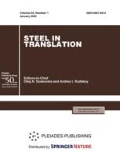Abstract
The influence of the mechanical performance of a workpiece material and the shape of the contact surface of a deformation region on the change in the yield point along the arc of roll contact under cold bar rolling is considered. The error in calculating the equivalent yield point during the replacement of a hardening curve with a linear and an exponential dependence is estimated. A hardening curve approximation is suggested the parameters of which depend on power n of the hardening curve, the initial deformation degree, and the equivalent yield point. This approximation is used to derive the analytical solutions of the von Karman equation for replacing the arc of roll contact and define the contact stresses and the roll effort. We compare the already known and new solutions by analysis. In particular, it is established that the replacement of an arc of roll with a chord at n = 1 weakens the design roll effort by 20% and greater.





Similar content being viewed by others
REFERENCES
Nikitin, G.S., Teoriya nepreryvnoi prodol’noi prokatki: uchebnoe posobie (Theory of Continuous Longitudinal Rolling: Manual), Moscow: Mosk. Gos. Tekh. Univ. im. N.E. Baumana, 2009.
Roberts, W.L., Cold Rolling of Steel, Boca Raton, FL: CRC Press, 1978.
Tselikov, A.I., Tomlenov, A.D., Zyuzin, V.I., et al., Teoriya prokatki: spravochnik (Theory of Rolling: Handbook), Moscow: Metallurgiya, 1982.
Rokotyan, E.S. and Rokotyan, S.E., Energosilovye parametry obzhimnykh i listovykh stanov (Power Parameters of Crimping and Sheet Rolling Mills), Moscow: Metallurgiya, 1969.
Tret’yakov, A.V., Teoriya, raschet i issledovaniya stanov kholodnoi prokatki (Theory, Calculation, and Research of Cold Rolling Mills), Moscow: Metallurgiya, 1966.
Smirnov, V.S., Teoriya obrabotki metallov davleniem (The Theory of Metal Pressuring), Moscow: Metallurgiya, 1973.
Baranov, G.L., Strain hardening in multipass drawing of a round nonhollow profile, Steel Transl., 2018, vol. 48, no. 9, pp. 606–609.
Baranov, G.L., Influence of strain hardening on the force in cold strip rolling, Steel Transl., 2018, vol. 48, no. 11, pp. 739–744.
Baranov, G.L., Influence of the strengthening curve on the axial stress in round rod on drawing, Steel Transl., 2018, vol. 48, no. 3, pp. 185–188.
Baranov, G.L., The influence of the hardening curve profile on the drawing force of a bar, Solid State Phenom., 2018, vol. 284, pp. 690–695. https://doi.org/10.4028/www.scientific.net/SSP.284.690
Tselikov, A.I., Teoriya rascheta usilii v prokatnykh stanakh (The Theory of Calculations of Forces in Rolling Mills), Moscow: Metallurgizdat, 1962.
Bland, D.R. and Ford, H., The calculation of roll force and torque in cold strip rolling with tension, Proc. Inst. Mech. Eng., 1948, vol. 159, no. 1, pp. 144–163.
Author information
Authors and Affiliations
Corresponding author
Additional information
Translated by S. Kuznetsov
About this article
Cite this article
Baranov, G.L. Considering the Shape of the Deformation Region when Defining Contact Stresses and Cold Rolling Force for a Plate of Strengthened Material. Steel Transl. 50, 491–495 (2020). https://doi.org/10.3103/S0967091220070037
Received:
Published:
Issue Date:
DOI: https://doi.org/10.3103/S0967091220070037



